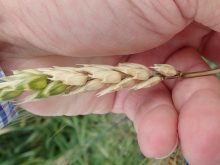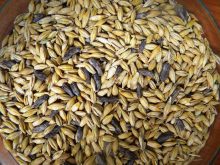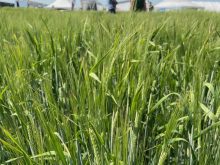Tom Hewson admits while there is always room for improving agronomic practices, his track record for producing malt barley has been quite respectable.
Hewson, who farms with family members at Langbank, in southeast Saskatchewan, says he has grown malting barley for many years. “I estimate on average about two-thirds of the years, about two-thirds of the crop will make malt quality,” he says. “Weather always seems to be the big factor, but 60 to 70 per cent of the time we’re able to market it for malt.”
Hewson, who grows AC Metcalfe malt barley in rotation with winter wheat, spring wheat and canola, says he aims to seed barley first — usually about May 1 — and he likes to seed it on canola stubble.
Read Also

Claas brings 1000 Series SP forage harvesters to Canada
In mid-August, Claas unveiled its new line of Jaguar forage harvesters at an event in Visalia, California, deep in the heart of that state’s dairy region.
“I know we should do a 1,000 kernel count when it comes to determining seeding rate,” he says. “But it has always worked well for me just to seed at 1-1/2 bushels per acre, so I stick with that. We do use good quality seed, with good germination, seed at a proper depth into moisture and most years have a very decent stand of barley.”
Following a soil test recommendation every year, Hewson aims to have about 100 lbs. of total nitrogen available to the barley crop (that includes the soil-available nitrogen as well as added nitrogen). He doesn’t want to over fertilize it, but he does like to see the odd patch of lodged barley “that tells me we are just pushing it a bit to optimize yields, but not too hard to affect protein,” says Hewson.
- Read more: Contracts a good idea with malt barley
Along with a pre-seeding or pre-emergent burnoff with a glyphosate product, he also applies recommended in-crop herbicide treatments for both grassy and broadleaf weeds. And particularly during the past 10 years with more (and sometimes excessive) growing-season moisture he always applies a fungicide for disease control. “We just figure on applying the fungicide because we’re expecting leaf diseases and hopefully it helps with fusarium headblight as well,” says Hewson.
Also in recent seasons, they also put harvested barley in aeration bins. “We take it off as early as we can, often we’re combining the first or second week of August,” says Hewson. “Depending on the year or field some may be swathed and some straight cut, and then we put it into aeration bins. If the barley is a bit tough that helps to dry it down.”
Hewson says the one drawback of combining barley so early, is that it can overlap with the winter wheat harvest and “we try to avoid going back and forth between the two crops,” he says. “If it works, it is nice to do one and then the other.”
Close to recommended practices
While Hewson may have to stay after school for not doing a 1,000-seed weight calculation to determine and actual seeding rate, his long-time malt barley production practices fit pretty closely with the recommended advice of crop specialists and researchers. Seed early, have an optimum (not too light, not too dense) plant stand, and applying moderate fertility are among the key recommended agronomic tips for barley growers.

Most researchers recommend for barley — in fact most cereal crop production —keep the seeding rate up, aiming for 22 to 25 to 30 and perhaps even 40 plants per square foot. That might be considered a heavy seeding rate/high plant count but a denser plant stand will help the crop compete with weeds, and also help achieve more even crop maturity.
John O’Donovan, a long-time research scientist now retired from Agriculture Canada in Lacombe, Alta. says the results of 21 site years of research looking at malt barley seeding rates show that targeting 300 seeds per square metre (about 30 seeds per square foot) appears to be the optimum rate for malt barley yield and quality.
“One of the issues has been that maltsters are looking for kernel plumpness, so many farmers were using lower seeding rates to increase plumpness,” says O’Donovan. “But we found if the seeding rate was too low, bad things happened.”
Lower seeding rates, and a thinner plant stand can lead to more tillering of the crop. That can lead to delayed and uneven maturity and that can contribute to more non-uniform kernels. The more uniform the kernels, the more malt quality is improved.
Higher seeding rate
“Overall we found that by going from 200 seeds per square metre to 300 seeds per square metre, we achieved higher yields, more uniform kernels, and improved malt quality,” says O’Donovan. “There was a slight reduction in kernel plumpness, but we felt the uniformity of the seed was more important.”
The research also showed that at the 300 seed rate, protein was slightly lower which is more desirable in malt barley. And by going from a seeding rate of 200 seeds per square metre to 300 seeds per square metre, crops matured two to three days sooner. “Which can make a huge difference when quality is the key and frost can quickly damage a crop.”
O’Donovan’s barley plots were direct seeded with an air seeding system calibrated for 300 seeds per square metre. They figured on 70 per cent emergence or about 220 to 230 viable plants per square metre (about 22 to 23 plants per square foot).
“So if you have a seeding system where you are expecting 95 per cent emergence for example, then you would need to adjust your seeding rate so you end up with about 220 to 230 plants per square metre,” he says.
More isn’t better with barley seeding rates, however, says O’Donovan. The 300 seeds per square metre rate seems optimum. A 400 and 500 seeds per square metre rate significantly reduced yield, likely due to lodging, and the economics of higher costs associated with the higher rate didn’t pencil out.

In southern Alberta, Ross McKenzie, Grainews columnist and long-time Alberta Agriculture research scientist now retired, says his research with crops produced under irrigation showed the optimum seeding rate for malt barley was 17 to 24 plants for square foot (he targeted 180 to 250 seeds per square metre).
For feed barley under irrigation it was slightly higher at 19 to 33 plants per square foot (200 to 350 seeds per square metre). And for hard red spring wheat under irrigation, 19 to 28 plants per square foot (200 to 300 seeds per square metre).
McKenzie says while every seeding system is different, he figures on an average emergence of between 60 and 80 per cent. “With most seeding systems if you are targeting a one-inch seeding depth, for example, you’re going to get some seeds at half-inch depth and some at two inches,” says McKenzie. “So you have to adjust the actual number of seeds planted to achieve the targeted viable plant count.”
Looking at wheat production in dryland farming, McKenzie says research shows the optimum seeding rate for soft white wheat in the all soil zones was 300 to 400 seeds per square metre (roughly 30 to 40 seeds per square foot) which should translate into about 21 to 28 actual plants per square foot.
With Canada Prairie Spring (CPS) wheat on dryland seeding rates ranged from 275 to 350 seeds per square metre (28 to 35 seeds per square metre) or a plant count of 20 to 25 plants per square foot in the dark brown soil zone, up to about 350 to 450 seeds per square metre or 25 to 32 plants per square foot in the black soil zone.
His research papers entitled: “Optimum Seeding Date and Rates for Irrigated Grain and Oilseed Crops” and “Dryland Agronomic Management of Soft White Spring Wheat and Canada Prairie Spring Wheat in Alberta” can both be found on the Alberta Agriculture website (www. agric.gov.ab.ca).
Early seeding is important
Along with the seeding rate, McKenzie says another important factor for farmers to consider is the seeding date. Generally researchers and crop specialists recommend an early seeding date is better than a late seeding date.
“Obviously you can’t seed every crop on the same day,” says McKenzie. “But, research shows yield is reduced by about one per cent per day (ranging from .6 to 1.7 per cent) for each day the crop is seeded after May 1.”
His research showed flax was the least affected by delayed seeding, losing about .6 per cent yield per day after May 1, while canola was the most affected losing nearly two per cent or 1.7 per cent of yield for each day seeding was delayed after May 1. Most of the cereal crops were in the one to 1.3 per cent per day range.
“The earlier you can get your crop seeded, without risk of damage, the better,” says McKenzie. “You may not want to seed canola on April 15 due to the risk of frost, but you may want to consider getting your peas, wheat and barley seeded in late April if conditions are suitable.”
McKenzie says farmers should look to get their highest value crops seeded first (to protect yield potential) and then schedule the rest of the crops later.
“If you can’t seed until May 1 and canola is your highest value crop then it would be best to seed canola first,” says McKeznie. “Then follow that with wheat and then barley. Since flax, for example, has the least potential for yield loss due to later seeding you could seed it last.”
Harry Brook, crop specialist with Alberta Agriculture says temperature is an important factor when it comes to seeding early. “You don’t want to be seeding into damp soil that is only 1 C,” he says. “You can loose a lot of seed to rot under those conditions.
“As a minimum, soil needs to be 5 C or better at time of seeding. If you can seed into a warm, moist seedbed, and seed shallow, that crop has an excellent chance of getting off to a good start. You might be able to seed peas at 4 C, but overall it is best to wait for at least 5 C before seeding.”
John O’Donovan had similar recommendations for malt barley. “In most areas we found that seeding early — seeding before the middle of May — produced the better yields,” he says. “The exception to that might be the Peace River Region where waiting a bit later until after the middle of May produced the best results.” And O’Donovan attributed that simply to cooler growing conditions in the Peace region earlier in the year.
“For most of the Prairies, except for the Peace region, earlier seeding of malt barley produced higher yields, improved quality characteristics and lower protein,” he says. “With later seedings the protein increased.” Reduce fertility.
Don’t overdue fertility
Too much fertility can be a disadvantage with malt barley. While yield and kernel weight might increase, higher fertility also increases protein and negatively affects nearly all other aspects of malting barley quality, including reductions in fine extract levels—which are very important to maltsters.
For best results, O’Donovan recommends applying 60 to 70 per cent of nitrogen listed in a soil test recommendation. Some of the newer malt barley varieties can handle a bit more nitrogen, but again, don’t overdo it.
And he recommends following a proper rotation. Seeding barley-on-barley generally reduces yield and quality, and increases disease as compared to planting barley on canola or field peas. Barley yields are highest (without significantly increasing the protein levels) when planted on field pea residue.
















